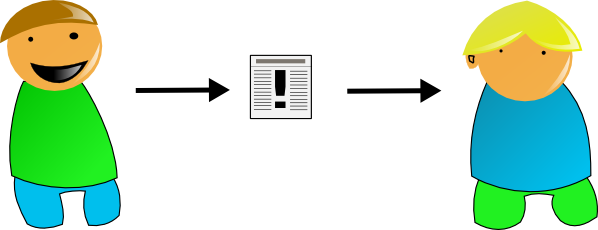1.2 Communication Basics
Communication is an ever-present phenomenon. It is such a dynamic and enduring process that often we are not even aware of when it starts or ends. We continue to develop our communication ability and knowledge throughout our lives. This book strives to assist in this development by providing the knowledge, theory, and practical application needed to create a solid foundation of knowledge of the complex concept we call communication.
There are countless definitions for the term “communication,” and they vary widely (ISU, 2016). However, before we discuss communication, it is important to define the term. Communication, for the purpose of this book, is the process of generating meaning by exchanging verbal and nonverbal symbols in various contexts. Although this is the definition used for this book, it is also important for you to develop your own definition of communication and what it means to you (ISU, 2016). This personalized definition will likely evolve and change as you go through this book, and then further develop through your future experiences.
Communication Is a Process
Communication is a process that involves an exchange of both verbal and nonverbal messages between individuals. When we refer to communication as a process, we imply that it doesn’t have a distinct beginning and end or follow a predetermined sequence of events. It can be very difficult to trace the origin of any communication encounter because communication doesn’t always follow a neat or discernible format, which makes studying communication interactions or phenomena difficult. There are, however, certain principles that apply to the concept of communication.
Communication Principles
The cognitive process that allows people to send, receive, and understand messages is the encoding and decoding process. Encoding is the process of turning thoughts into communication by the sender of the information. The level of conscious thought that goes into encoding messages varies. Decoding is the process of turning communication into thoughts by those that receive the information from others. For example, you may realize you’re hungry and encode the following message to send to a family member: “I’m hungry. Do you want to get pizza tonight?” As your family member receives the message, they decode your communication and turn it back into thoughts to make meaning out of it. Image 1.1 provides a basic illustration of communication between a sender and receiver.
Of course, we don’t just communicate verbally—we have various options, or channels, for communication. Encoded messages are sent through a channel—a sensory route on which a message travels—to the receiver for decoding. Although communication can be sent and received using any sensory route (sight, smell, touch, taste, or sound), most communication occurs through visual and auditory channels.

The amount of conscious thought that goes into communication varies. In general, we can say that intentional communication usually includes more conscious thought, and unintentional communication usually includes less. For example, some communication is reactionary and almost completely involuntary. We often scream when we are frightened, say “Ouch!” when we stub a toe, and stare blankly when we are bored. This isn’t the richest type of communication, but it is communication. Some of our interactions are more substantial and include more conscious thought but are still very routine. For example, we say “Excuse me” when we need to get past someone, “Thank you” when someone holds the door for us, or “What’s up?” to a co-worker we pass every day in the hall. The reactionary and routine types of communication just discussed are common, but the messages that are most studied by communication scholars are considered constructed communication. These messages include more conscious thought and intention than reactionary or routine messages and often go beyond information exchange to also meet relational and identity needs, which will be discussed on the next page.
The dynamic nature of the communication process also means that communication is irreversible. After an initial interaction has gone wrong, characters in sitcoms and romantic comedies often use the line “Can we just start over?” As handy as it would be to be able to turn the clock back and “redo” a failed or embarrassing communication encounter, it is impossible. Miscommunication can occur regardless of the degree of conscious thought and intention put into a message. For example, if someone tells a joke that offends a co-worker, that person can’t just say, “Oh, forget I said that” or “I didn’t intend for it to be offensive.” The message has been sent, and it can’t be taken back. I’m sure we have all wished we could retract something we have said. Conversely, when communication goes well, we often wish we could recreate it. However, in addition to communication being irreversible, it is also unrepeatable.
If you try to recreate a good job interview experience by asking the same questions and telling the same stories about yourself, you can’t expect the same results. Even trying to repeat a communication encounter with the same person won’t feel identical or lead to the same results. The context of communication inevitably impacts the outcome, and context is ever-changing. Even if the words and actions stay the same, the physical, psychological, social, relational, and cultural contexts will vary and ultimately change the communication encounter. Have you ever tried to recount a funny or interesting experience to a friend who doesn’t really seem that impressed? These “You had to be there” moments illustrate the fact that communication is unrepeatable.
Content and relational dimensions are also important aspects of communication and are present in all communication exchanges. Content dimension refers to the content within a message. For example, the request “Turn up the heat,” contains the content that the house is cold, so the heat needs to be turned up. Relational dimension includes the existing interpersonal history and type of relationship we have with a person. We communicate differently with someone we just met versus someone we have known for a long time. For example, your tone or body language may be different when saying “Turn up the heat,” depending on how well you know the person and how well they know you. In Image 1.2 below, the couple appears to have a close, long-term relationship, and their verbal and nonverbal communication shows that. Initial interactions with people tend to be more highly scripted and governed by established norms and rules, but when we have an established relational context, we may be able to bend or break social norms and rules more easily. For example, you would likely follow social norms of politeness and attentiveness and might spend the whole day cleaning the house the first time you invite your new neighbours to visit. Once the neighbours are in your house, you may also make them the centre of your attention during their visit. If you end up becoming friends with your neighbours and establishing a relational context, you might not think as much about having everything cleaned and prepared or even giving them all your attention during later visits. Since communication norms and rules also vary based on the type of relationship people have, the relationship type is also part of the relational context.

Communication is a complex process, and it is often difficult to determine where or with whom a communication encounter starts and ends because there may not be a specific start and end point. Communication may seem like a continuous process at times, and really, it is impossible not to communicate with others. Verbal and nonverbal communication occurs all the time. Models of communication simplify the process by providing a visual representation of the various aspects of a communication encounter. Some models explain communication in more detail than others, but even the most complex model can’t recreate what we experience in a single moment of a communication encounter. Models still serve a valuable purpose because they allow us to see specific concepts and steps within the process of communication, define communication, and apply communication concepts. When you become aware of how communication functions, you can think more deliberately through your communication encounters, which can help you better prepare for future communication and learn from your previous communication.
Communication Meets Needs
Communication is far more than the transmission of information. We exchange messages and information for many important reasons and while the content of our communication may help us achieve certain physical and instrumental needs, it also feeds into our identities and relationships in ways that far exceed the content of the message we say verbally. Communication is needed to help meet various needs such as physical, instrumental, relational, and identity needs.
Physical Needs
Physical needs include needs that keep our bodies and minds functioning. Often when someone thinks about communication, it is associated with our brain, mouth, eyes, and ears; however, it has many more connections to our physical body and well-being. Even at the most basic level, communication can let others know that our physical needs are not being met. For example, babies communicate to let their caregivers know that they are hungry or cold, as shown in Image. 1.3. Human beings are social creatures, which makes communication important for our survival. Aside from surviving, communication skills can also help us thrive. Communication can also be therapeutic, which may lessen or prevent physical problems. Satisfying physical needs is essential for our physical functioning and survival, but in order to socially function and thrive, we must also meet instrumental, relational, and identity needs.

Instrumental Needs
Instrumental needs include needs that help us get things done in our day-to-day lives and achieve short- and long-term goals. We all have short- and long-term goals that we work on every day. Fulfilling these goals is an ongoing communication task, which means we spend much of our time communicating for instrumental needs. To meet these needs, we often use communication strategically. Politicians, parents, bosses, and friends use communication to influence others in order to accomplish goals and meet needs. In short, communication that meets our instrumental needs helps us “get things done.”
Relational Needs
Relational needs include needs that help us maintain social bonds and interpersonal relationships. Communicating to fill our instrumental needs helps us function on many levels, but communicating for relational needs helps us achieve the social relating that is an essential part of being human. Communication meets our relational needs by giving us a tool through which to develop, maintain, and end relationships. To develop a relationship, we may use nonverbal communication to assess whether or not someone is interested in talking to us, then use verbal communication to strike up a conversation. Then, through the mutual process of self-disclosure, a relationship forms over time. Once formed, we need to maintain the relationship, so we use communication to express our continued liking of someone. We can verbally say things like “You’re such a great friend” or engage in behaviours that communicate our investment in the relationship, like organizing a birthday party. Although our relationships vary in terms of closeness and intimacy, all individuals have relational needs, and all relationships require maintenance. Finally, communication, or the lack of it, helps us end relationships. We may communicate our deteriorating commitment to a relationship by avoiding communication with someone, verbally criticizing the other person, or explicitly ending the relationship.
Identity Needs
Identity needs include our need to present ourselves to others and be thought of in particular and desired ways. What adjectives would you use to describe yourself? Are you funny, smart, loyal, or quirky? Your answer isn’t just based on who you think you are because much of how we think of ourselves is based on our communication with other people. Our identity changes as we progress through life, but communication is the primary means of establishing our identity and fulfilling our identity needs. Communication allows us to present ourselves to others in particular ways. Just as many companies, celebrities, and politicians create a public image, we present different faces in different contexts.
Relating Theory to Real Life
- Consider your own definition of communication.
- What is it?
- Now compare your definition to the definition of a classmate or friend.
- How is the other person’s definition different? How is it the same?
- After hearing their definition, does that change yours at all?
- Identify some physical, instrumental, relational, and identity needs that communication helps you meet in a given day.
- In this section, we learned that communication is irreversible and unrepeatable. Identify a situation in which you wished you could reverse communication. Then identify a situation in which you wished you could repeat communication. Even though it’s impossible to reverse or repeat communication, what lessons can be learned from the two situations you identified? How can you can apply this to future communication?
Attribution
Unless otherwise indicated, material on this page has been reproduced or adapted from the following resource:
University of Minnesota. (2016). Communication in the real world: An introduction to communication studies. University of Minnesota Libraries Publishing. https://open.lib.umn.edu/communication, licensed under CC BY-NC-SA 4.0, except where otherwise noted.
References
Department of Communication, Indiana State University (ISU). (2016). Introduction to public communication. Indiana State University. http://kell.indstate.edu/public-comm-intro/, licensed under CC BY-SA 4.0
Image Credits (images are listed in order of appearance)
Communication sender-message-reciever by Einar Faanes, CC BY-SA 3.0
The way you hold me by William Stitt willpower, Unsplash licence

